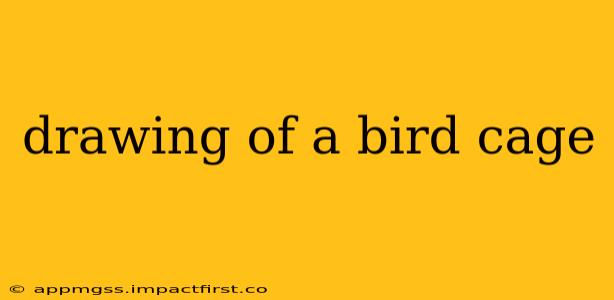How to Draw a Bird Cage: A Step-by-Step Guide for Artists of All Levels
Drawing a birdcage might seem simple, but capturing its delicate structure and overall charm requires attention to detail and understanding of perspective. This guide will take you through the process, from basic shapes to adding intricate details, suitable for both beginners and experienced artists. We'll cover various styles and techniques to help you create your perfect birdcage drawing.
What materials will I need?
Before we begin, gather your materials. You'll need:
- Paper: Use drawing paper, sketchbook paper, or even printer paper, depending on your preference and the desired final look. Heavier weight paper is preferable for more intricate drawings and watercolor techniques.
- Pencils: A range of pencils (HB, 2B, 4B, etc.) will allow you to vary line weight and shading. A mechanical pencil is also a good choice for consistent lines.
- Eraser: A kneaded eraser is ideal for lifting graphite without damaging the paper's surface. A vinyl eraser is also a good option.
- Sharpener: Keep your pencils sharp for clean lines and precise details.
- Ruler (optional): Useful for creating straight lines and maintaining proportions, particularly for geometric cages.
Step-by-Step Drawing Process:
1. Basic Shapes: Start by sketching the overall shape of the cage using simple geometric forms. Think of a cylinder or a rectangular prism for the main body, and circles or squares for the top and bottom. Lightly sketch these shapes to allow for adjustments.
2. Cage Bars: Add the vertical bars first, ensuring they're evenly spaced. Then, add the horizontal bars, creating a grid-like structure. Remember to consider perspective; bars that are further away will appear smaller and closer together.
3. Door and Details: Sketch a small rectangular door on one side of the cage. Add small details like hinges and a latch. You can also add decorative elements like scrolls or curves to the cage's frame, depending on the style of birdcage you're drawing.
4. Base and Stand: Draw the base of the cage, often a circular or square platform. For a more realistic look, add a stand or legs to support the cage.
5. Shading and Texture: Use shading techniques to create depth and dimension. Consider the light source and how it affects the shadows within the cage. Experiment with different shading techniques like hatching, cross-hatching, and blending to achieve the desired texture.
6. Adding a Bird (Optional): If you wish, add a small bird inside the cage. Keep its proportions realistic and consider its position relative to the cage's structure.
7. Refinement and Final Touches: Once you're happy with your sketch, you can refine the lines, erase unwanted marks, and add final details. You can then ink your drawing or leave it as a pencil sketch.
Different Styles of Birdcage Drawings:
-
Realistic Birdcage: Focus on accurate proportions, detailed shading, and realistic textures. Pay close attention to the materials used in constructing the cage (wood, metal, etc.).
-
Cartoon Birdcage: Use simplified shapes, exaggerated features, and bold lines. Focus on creating a charming and playful representation.
-
Geometric Birdcage: Emphasize geometric shapes and clean lines. This style can be minimalist and modern.
What are some common mistakes to avoid when drawing a birdcage?
- Uneven spacing of bars: Pay close attention to the spacing between the bars to avoid a haphazard look.
- Ignoring perspective: Remember that bars further away should appear smaller and closer together.
- Lack of shading: Shading is crucial for creating depth and realism.
- Inconsistent line weight: Varying line weight can add interest and visual appeal.
By following these steps and experimenting with different techniques, you'll be able to create stunning drawings of birdcages, whether realistic, stylized, or abstract. Remember to practice and have fun!
